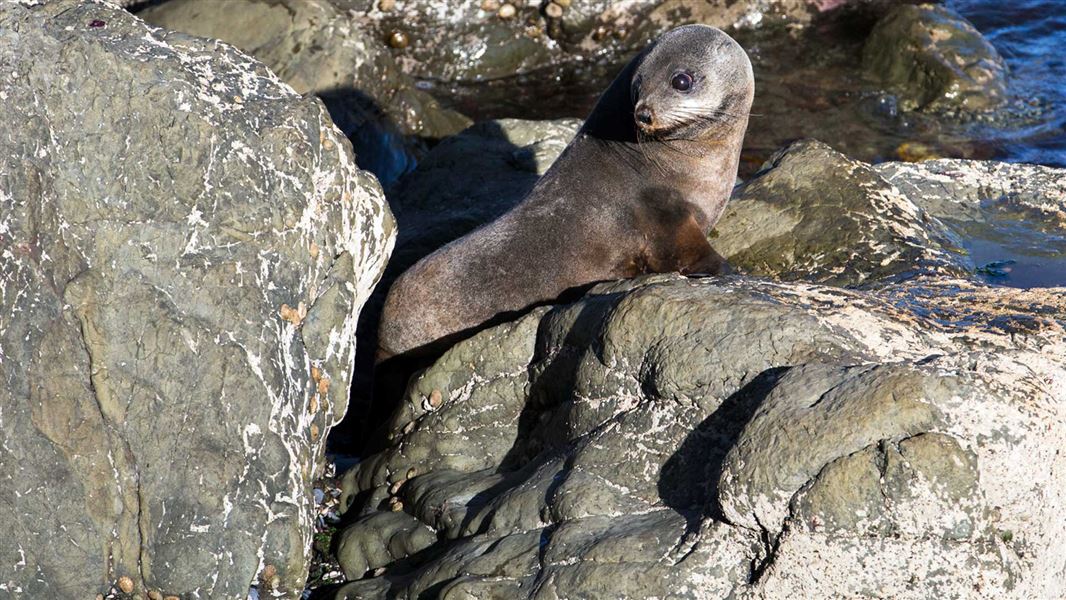Archived content: This media release was accurate on the date of publication.
Date: 12 June 2023
Between May and September young kekeno/seals and male seals of any age can be spotted as they leave their breeding colonies, explore, and rest. This includes newly weaned pups finding their way in the world.
“Fur seal populations are recovering quickly,” says Marine Science Advisor Laura Boren. “This means people need to be prepared to encounter seals anywhere around our coastline, even in areas where they haven’t seen seals before, and particularly over the winter months.”
Although kekeno are marine mammals, they spend much of their time on land resting and basking in the sun. They are most often found on rocky shores, although they are curious and exploratory by nature are frequently spotted inland. In 2021, a seal spent several days in Hobbiton, near the Waikato town of Matamatamore than 90 km from the nearest seashore. Also in 2021, a young kekeno found its way onto SH25A near Thames, briefly stopping traffic as parents ferried their children to a local school.
One way for people to help keep kekeno safe during this season is to keep dogs under control.
“Our hotline staff frequently receive calls about dogs harassing and attacking seals,” says Laura. “And what is reported is only a fraction of what actually occurs.”
“This is a year-round issue but particularly this time of year, when you can come across seals in unexpected places.”
People are reminded to follow some simple guidelines when out walking their dogs:
- Scan for wildlife – a sleeping seal can look a lot like driftwood.
- Keep a toy on hand to use as a distraction.
- Warn other beach users if you spot wildlife.
- Keep a lead on you at all times (this is also a legal requirement).
- Check DOC and council websites for seasonal and area dog restrictions.
- Become a wildlife wise dog owner through the Lead the Way programme.
Lead the Way programme partner and pet insurance provider PD Insurance explains that although dog owners have good intentions towards wildlife, many are unaware of the harm their pet can do.
“It is especially important at this time of year to be wildlife wise when walking your dog along the coastline, where kekeno rely on the community to keep them safe in their home environment. Even a dog curiously snuffling around can unintentionally damage native wildlife, particularly when that curiosity naturally turns into playing or more,” says COO Michelle Le Long.
“Another way to protect kekeno is to keep a sharp watch out for them while driving,” says Moss Thompson, Community Ranger in Coastal Otago.
“Tragically, every year there are vehicle strikes involving kekeno, especially pups. NZ sea lions have also been victims of vehicle strikes, particularly in the Otago and Southland regions.”
“Keep your speed down in coastal areas, and keep your eyes peeled for animals on the road, particularly around dawn and dusk.”
Kekeno are exploratory by nature and exhibit some strange behaviours when hauled-up on land. People may feel concerned seeing young pups alone, or seals regurgitating, sneezing, coughing, or crying.
“This is all part of their normal behaviour, and they are very resilient animals. Watch, enjoy them from a distance, and let them be. Call the DOC hotline only if they are in immediate danger, like relaxing on a road, severely injured, or tangled in debris.”
DOC takes a hands-off approach with seals and will only intervene if the animal is in danger, or in high-traffic urban areas.
If you see a seal which is severely injured, being harassed, or in obvious danger, call 0800 DOC HOT (0800 362 468).
Contact
For media enquiries contact:
Email: media@doc.govt.nz
